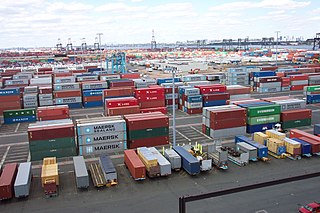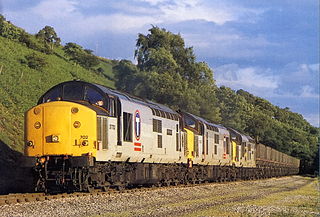Related Research Articles

Containerization is a system of intermodal freight transport using intermodal containers. Containerization, also referred as container stuffing or container loading, is the process of unitization of cargoes in exports. Containerization is the predominant form of unitization of export cargoes, as opposed to other systems such as the barge system or palletization. The containers have standardized dimensions. They can be loaded and unloaded, stacked, transported efficiently over long distances, and transferred from one mode of transport to another—container ships, rail transport flatcars, and semi-trailer trucks—without being opened. The handling system is mechanized so that all handling is done with cranes and special forklift trucks. All containers are numbered and tracked using computerized systems.

An intermodal container, often called a shipping container, or cargo container, (or simply “container”) is a large metal crate designed and built for intermodal freight transport, meaning these containers can be used across different modes of transport – such as from ships to trains to trucks – without unloading and reloading their cargo. Intermodal containers are primarily used to store and transport materials and products efficiently and securely in the global containerized intermodal freight transport system, but smaller numbers are in regional use as well. It is like a boxcar that does not have wheels. Based on size alone, up to 95% of intermodal containers comply with ISO standards, and can officially be called ISO containers. These containers are known by many names: freight container, sea container, ocean container, container van or sea van, sea can or C can, or MILVAN, or SEAVAN. The term CONEX (Box) is a technically incorrect carry-over usage of the name of an important predecessor of the ISO containers: the much smaller steel CONEX boxes used by the U.S. Army.

Intermodal freight transport involves the transportation of freight in an intermodal container or vehicle, using multiple modes of transportation, without any handling of the freight itself when changing modes. The method reduces cargo handling, and so improves security, reduces damage and loss, and allows freight to be transported faster. Reduced costs over road trucking is the key benefit for inter-continental use. This may be offset by reduced timings for road transport over shorter distances.

Freightliner Group is a rail freight and logistics company headquartered in the United Kingdom.

A sidelifter is a specialised vehicle or semi-trailer used to hoist and transport ISO standard intermodal containers over longer distances.

Lithuanian Railways, is the national state-owned railway company of Lithuania. It operates most of the railway network in the country. It has several subsidiary companies, but the main ones are: LTG Link which provides passenger services, LTG Cargo which provides freight service, and LTG Infra which is responsible for the maintenance and development of the infrastructure.

A swap body, exchangeable container or interchangeable unit, is one of the types of standard freight containers for road and rail transport.

Railfreight Distribution was a sub-sector of British Rail, created by the division in 1987 of British Rail's previous Railfreight sector. It was responsible for non-trainload freight operations, as well as Freightliner and Intermodal services. In its early years, the division was occasionally referred to as Speedlink Distribution. It was later responsible for freight operations through the Channel Tunnel.

Rail freight transport is the use of railways and trains to transport cargo as opposed to human passengers.

London Thamesport was a small container seaport on the River Medway, serving the North Sea. It is located on the Isle of Grain, in the Medway unitary authority district of the English county of Kent. The area was formerly called Port Victoria. Since early 2020, Thamesport has no longer operated as a container port, having been eclipsed by the new and much larger London Gateway container port on the Essex coast of the Thames Estuary.

The Greenwich Park branch line is a short section of railway line in south east London which links the Catford loop line to the South Eastern Main Line which originally terminated at Greenwich Park station. It provides a link for freight trains travelling from north London to the south east, as well as a route for passenger trains from London Victoria station to destinations in South East London and Kent.

SBB Cargo is a subsidiary of Swiss Federal Railways (SBB) specialising in railfreight and is operated as the Freight division. Swiss Federal Railways is a former state-owned and -controlled company that was transformed in 1999 into a joint-stock company under special legislation following the first Swiss railway reform and divided up into three independent divisions: Passenger, Freight and Infrastructure. The headquarters of Swiss Federal Railways SBB Cargo AG, the Freight division's official designation, are in Olten. In 2013, SBB Cargo had 3,061 employees and achieved consolidated sales of CHF 953 million. In Switzerland, SBB Cargo is the market leader in rail freight, transporting over 175,000 tons of goods every day. This corresponds to the weight of 425 fully loaded jumbo jets.

Transfesa is a transport company based in Madrid, Spain. It is a transport and logistics service provider and European intermodal operator. As of 2007 The company has five major terminals in Spain at Madrid, Barcelona, Valencia, Saragossa and Burgos, and ten intermodal logistics facilities.

The railway network in Great Britain has been used to transport goods of various types and in varying volumes since the early 19th century. Network Rail, which owns and maintains the network, aims to increase the amount of goods carried by rail. In 2015–16 Britain's railways moved 17.8 billion net tonne kilometres, a 20% fall compared to 2014–15. Coal accounted for 13.1% of goods transport in Britain, down considerably from previous years. There are no goods transported by railway in Northern Ireland.

Toll Domestic Forwarding (TDF) is a division of the Toll Group specialising in freight forwarding by road, rail and sea within and between Australia and New Zealand.

Steelbro Group is a heavy vehicle and crane manufacturer headquartered in Christchurch, New Zealand. In 2013 it owned the Steelbro, Transtank, Fuelgear and Freightquip businesses.

Stobart Rail Freight Ltd was a railway freight service operator in the United Kingdom. It came under the Rail division of Eddie Stobart Logistics, and carried intermodal freight for the group.

Stourton Freightliner Terminal, is a railfreight intermodal transport hub located in Stourton, Leeds, England. It is operated by the Freightliner Group, and has services arriving and departing for ports in Felixstowe, Southampton and Tilbury in the south of England. Stourton serves as a dedicated collection and delivery point for containers across Yorkshire, with a minor sub-service to Teesport in Middlesbrough by rail.

Intermodal railfreight in Great Britain is a way of transporting containers between ports, inland ports and terminals in England, Scotland and Wales, by using rail to do so. Initially started by British Rail in the 1960s, the use of containers that could be swapped between different modes of transport goes back to the days of the London, Midland & Scottish Railway.

A container chassis, also called intermodal chassis or skeletal trailer, is a type of semi-trailer designed to securely carry an intermodal container. Chassis are used by truckers to deliver containers between ports, railyards, container depots, and shipper facilities, and are thus a key part of the intermodal supply chain.
References
- ↑ Containerlift brings Thamesport 50 miles closer to London Rail Freight Group 17 January 2006
- ↑ "Schedule of moving out - Separating the sensitive valuables" . Retrieved 21 September 2023.